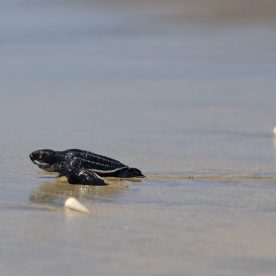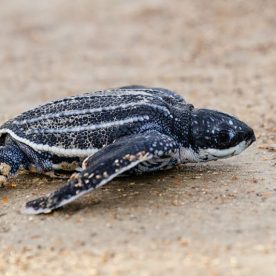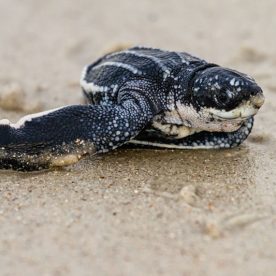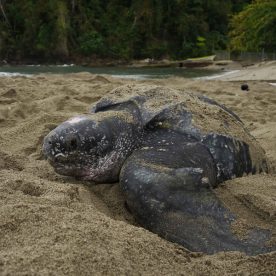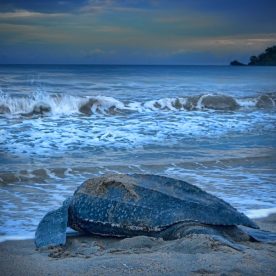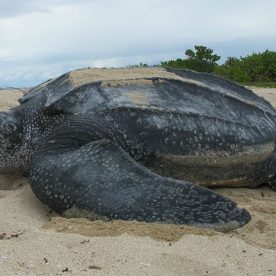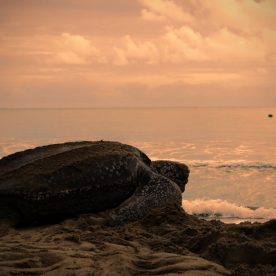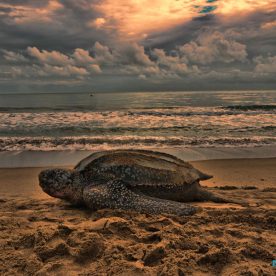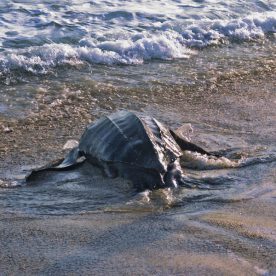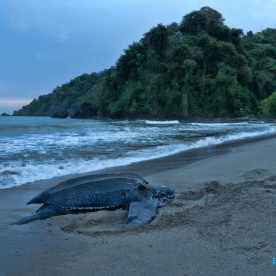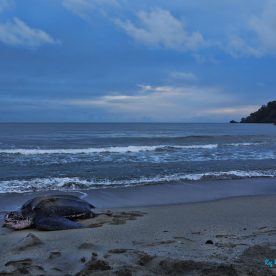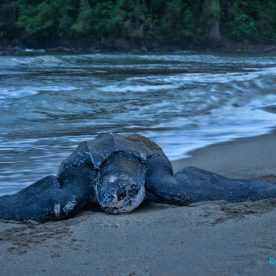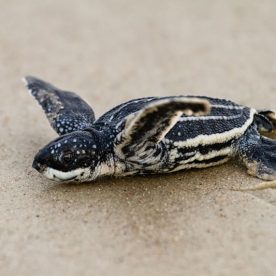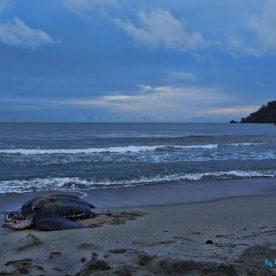Description
The leatherback seaturtle is the world’s largest reptile. It is significantly larger than all other marine turtles. The leatherback’s body is teardrop-shaped, tapering at the rear to a blunt point. The carapace, or upper shell, can grow to more than 2 m in length, and the turtle can weigh more than 900 kg. Like all sea turtles, the leatherback has both front and rear flippers, but it is the only sea turtle whose flippers have no claws. Its large front flippers are usually at least half as long as its carapace. The leatherback, like other sea turtles, cannot retract its head or flippers under its shell as tortoises and freshwater turtles can.
The leatherback is also the only sea turtle that does not have a hard shell or scales. Instead, its carapace is covered with the leathery skin that gives the turtle its name. The skin covers a thick layer of oil-saturated fat and connective tissue and a matrix of small bony plates that fit together, almost like a jigsaw puzzle, to form the shell. Seven ridges run the length of the turtle’s carapace, which is a dark bluish-black colour. Sometimes the turtle’s carapace appears brown when it is seen in the water. The leatherback’s carapace, neck, head, and front flippers are usually covered with white or bluish-white blotches. Its plastron, or bottom shell, is pinkish-white.
Leatherbacks have a pink patch on the top of the head. Each pink spot, like a human fingerprint, is unique. Scientists are not certain what function the pink spot has, though some think it might help the turtle sense light or determine where it is located in the ocean.
Habitat and Habits
Leatherbacks are powerful swimmers, covering enormous distances in relatively short periods of time. For example, a turtle that was found in the waters off Cape Breton Island, Nova Scotia, travelled as far south as Trinidad in four months. Using their front flippers in a motion that looks much like a bird flapping its wings, leatherbacks propel themselves through the water. Scientists have recorded speeds of up 9.3 km per hour, but a likely average is closer to 2.5 km per hour.
Leatherbacks are one of the world’s deepest-diving vertebrates. The maximum recorded dive depth for a leatherback is 1 270 m. Like all reptiles, the leatherback breathes air. Although it is able to stay under water for more than an hour, a leatherback usually does not spend much more than half an hour beneath the surface.
Unique characteristics
A combination of adaptations allows leatherbacks to survive in water that is much too cold for other marine turtles. These include the dark body colour, a thick layer of fat, and a high volume-to-surface-area ratio. This means that the turtle has a significant body mass, or volume, and a relatively small surface area compared to the mass, allowing the turtle to retain body heat.
Leatherbacks also have “countercurrent” heat exchangers in their flippers. This means that the veins and arteries are closely bundled next to one another, so that the warmer blood carried away from the heart in the arteries helps to warm the cooler blood returning to the heart from the veins. All of these factors help the leatherback maintain a core body, or internal, temperature, which is as much as 18°C warmer than the surrounding water temperature. Some scientists even hypothesize that the leatherback might have some capacity to generate its own body heat, like a mammal, even though reptiles are ectotherms — or “cold-blooded” — which means that their body temperature depends upon the temperature of the surrounding environment.
The leatherback has never developed the ability to swim backwards. This poses some difficulty when an animal encounters fishing nets and lines in the ocean because it has no hope of backing out of them. It also poses a major difficulty to scientists attempting to raise leatherbacks in captivity. In fact, leatherbacks have never been successfully raised to maturity in captivity.
Leatherbacks kept in a tank continually propel themselves against the sides of the aquarium as they ceaselessly swim forward. They inevitably damage themselves in the process and develop lethal fungal infections as a result. Not being able to raise leatherbacks in captivity means that scientists cannot observe captive specimens to determine how quickly they grow or how long they live. It also means that a “head-start” program cannot supplement leatherback conservation efforts. A head-start program would keep hatchling leatherbacks in captivity until they grew to a size that makes them less vulnerable to predators.
Because male turtles never return to land after hatching, collecting information on males must take place at sea, a difficult prospect given the great distances the turtles travel. The majority of leatherback scientists study individuals on the nesting beaches. As a result, the information available on leatherbacks is heavily biased toward female turtles.
Range
The leatherback seaturtle ranges further than any other reptile, with single turtles migrating across entire ocean basins. Leatherbacks can be found in the tropical, temperate, and boreal, or northernmost, waters of the Atlantic, Pacific, and Indian oceans. They are also found in the Mediterranean Sea. The northernmost recorded latitude of a leatherback is 71°N and the southernmost is approximately 27°S. In Canada, the leatherback seaturtle can be found off the coasts of British Columbia, Nova Scotia, Newfoundland and Labrador, New Brunswick, and Prince Edward Island. There have also been records of turtles off Baffin Island and in the Gulf of St. Lawrence near the city of Québec.
Although scientists have a sense of where leatherbacks are found in the world, they are still in the early stages of understanding what migration routes leatherbacks take to get from the tropical waters near their nesting beaches to the temperate and boreal waters where they forage, or search for food, at other times of the year. This information is crucial to helping conserve the leatherback.
Feeding
The primary reason that leatherbacks migrate north is to feed on jellyfish, which are their principal prey. The turtles will also eat other soft-bodied creatures, such as salps. Salps are soft-bodied, gelatinous, free-swimming marine invertebrates with a transparent barrel-shaped body.
Like all turtles, leatherbacks do not have teeth. They do have two cusps, or pointed parts, one on the upper jaw and one on the lower jaw. These are not used to “chew” food, but to grab it. To aid in feeding, the leatherback’s entire esophageal tract, or gullet, is lined with sharp spines that point downward. Scientists suggest that these spines prevent jellyfish from escaping from the leatherback’s mouth, and they help to shred the jellyfish to pieces as it travels down the esophagus to the turtle’s stomach.
Breeding
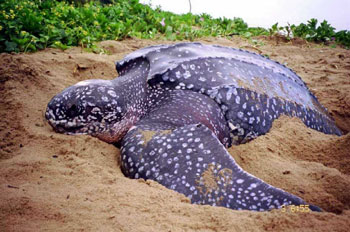
Like almost all reptiles, leatherback seaturtles hatch from eggs laid on land. The major leatherback nesting beaches are in Trinidad, French Guiana, Suriname, St. Croix and the United States Virgin Islands, Papua New Guinea, Mexico, Pacific Costa Rica, Irian Jaya, and Gabon. They do not nest in Canada. In the United States, the turtles nest in Florida and occasionally in Georgia.
Nesting is the only time a sea turtle will return to land, and only the females nest. Male turtles never return to land after hatching. Mating takes place at sea.
Leatherbacks nest every two to three years. Atlantic leatherbacks nest an average of six times from March to July, with approximately 10 days between the nesting episodes, while Pacific leatherbacks are thought to nest fewer than five times between September and March. To lay their eggs, almost all leatherbacks will return to the beach where they themselves hatched.
When she is ready to nest, a process that will take between one-and-a-half to two hours, a female leatherback will haul herself to shore, usually late at night. Leatherbacks are quick in the water but are extremely slow and cumbersome on land. The turtle slowly drags herself up the beach using her front flippers, stopping when she finds what appears to be a suitable place for the nest. Often turtles will lay their nests in areas that are underwater during high tide, resulting in the drowning of many eggs.
The turtle first uses her flippers to scrape out a body cavity for herself. Then she uses her rear flippers to dig out the egg chamber, which is shaped like a deep flask. It is usually as deep as the rear flippers are long. When the egg chamber is ready, the turtle lays her eggs, which are approximately the size of a billiard ball and have a rubbery shell, which helps to keep them from breaking as they fall into the chamber on top of one another. A leatherback lays from 60 to 90 yolked eggs. On top of these she lays several yolkless eggs. Some scientists think these “dummy” eggs allow oxygen to continue circulating around the fertile eggs by helping to prevent sand from falling between them.
After the turtle has laid her eggs, she covers the nest with sand and packs it down with her rear flippers. She then uses her front flippers to throw sand around to help disguise the body cavity and the nest before heading back to the ocean. Although her efforts to disguise the nest may be successful, she leaves an unmistakable trail leading from the nesting site with her body and front flippers as she returns to sea.
Leatherbacks hatch approximately 60 to 65 days after the eggs are laid. The hatchlings remain buried in their nest for a time after they have broken out of their eggs. There is enough oxygen within the nest for them to survive. They begin to rise to the surface of the nest by scrambling around. This causes the sand from the ceiling and walls of the nest to be deposited on the bottom of the nest, slowly raising the turtles to the surface of the beach. The turtles usually emerge from their nests before dawn. The hatchlings typically have a carapace length of 5.1 cm to 6.8 cm. They are black, and the ridges along their carapace are clearly outlined in white.
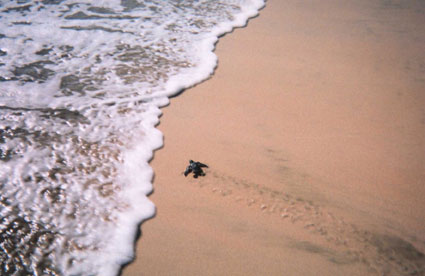 After they emerge from the nest, the hatchlings look for the brightest spot on the horizon, which is normally the sea reflecting whatever light there is in the sky. Their trip from the nest to the sea is dangerous. On the beach, they are tempting prey for ghost crabs, gulls, crows, vultures, hawks, and coatis, a raccoon-like mammal found in South America. If the hatchlings emerge from a nest that is located on a beach that includes or is near a developed area, such as a resort, they may find that the brightest spot on the horizon is not the sea, but rather the light coming from the development. This causes the hatchlings to become disoriented and to head away from the ocean instead of toward it, increasing their risk of predation and dehydration before successfully reaching water. Once they are in the ocean, the turtles become potential prey for octopi, sharks, and other large fish.
After they emerge from the nest, the hatchlings look for the brightest spot on the horizon, which is normally the sea reflecting whatever light there is in the sky. Their trip from the nest to the sea is dangerous. On the beach, they are tempting prey for ghost crabs, gulls, crows, vultures, hawks, and coatis, a raccoon-like mammal found in South America. If the hatchlings emerge from a nest that is located on a beach that includes or is near a developed area, such as a resort, they may find that the brightest spot on the horizon is not the sea, but rather the light coming from the development. This causes the hatchlings to become disoriented and to head away from the ocean instead of toward it, increasing their risk of predation and dehydration before successfully reaching water. Once they are in the ocean, the turtles become potential prey for octopi, sharks, and other large fish.
Another mystery surrounding leatherbacks is where hatchlings go between the time they are small and the time they return to the nesting beaches as adults. Sightings of juvenile turtles are extremely rare, and there is little information on the biology, distribution, or habits of young turtles, although recent research suggests that hatchlings remain in tropical waters until their carapace is a metre long.
Conservation
The leatherback seaturtle is classified as critically endangered by the World Conservation Union and as endangered by the Committee on the Status of Endangered Wildlife in Canada. Leatherbacks have experienced a dramatic population decline of more than 60 per cent since 1982. Because male turtles do not return to land, it is not possible to accurately count them. So scientists determine the population of sea turtles by counting nesting females. Currently, the total number of nesting females is thought to be less than 35 000 worldwide.
The leatherback has also been listed in the Convention on International Trade in Endangered Species of Wild Flora and Fauna (CITES). Canada signed this treaty, as have many of the countries that host nesting or migratory populations of leatherbacks. CITES attempts to ensure that trade in endangered species does not threaten the existence of the turtle. In Canada, leatherback seaturtles, as marine reptiles, fall into the definition of “fish.” As such, they are protected by the Fisheries Act, which makes it illegal to take or kill “fish” without a permit from Fisheries and Oceans Canada. The Fisheries Act can be used to prohibit or restrict directed commercial, recreational, or subsistence fishing activity, but at present there are no regulations on incidental catch of this species. The habitat protection provisions of the Fisheries Act are available to protect any marine, estuarine, or freshwater habitat utilized by this species.
Numerous threats to the leatherback have contributed to its endangered status. The mortality rate of hatchlings due to predation is high, though once they reach adult size, leatherbacks have few natural predators. Large sharks or killer whales may attack the turtles at sea, and it is not unusual to see leatherbacks with partially amputated flippers as a result of these attacks. Jaguars occasionally attack nesting female turtles.
The greatest predator of the leatherback, however, is people. In some countries, humans kill nesting female turtles and harvest leatherback eggs to eat. Because leatherbacks move very slowly on land, they are not able to defend themselves from humans on the nesting beaches. And because the turtles leave a trail to their nests when they make their way back to the water, the nests are easy for egg poachers to locate. Environmental groups in many of the nesting beach regions have implemented “beach watch” programs, where volunteers walk the beaches at night trying to protect the turtles from human predators.
Most threats to the turtles in the ocean also come from humans. Leatherbacks may become entangled in different types of fishing gear. Although many fishers are careful to disentangle the turtles that are accidentally caught in their fishing lines, not all of them do. Entanglement in fishing gear can result in serious injuries to the turtles, including severe cuts and necrosis, or death of the tissue, which could lead to the loss of a flipper; entanglement can also lead to death by drowning. Unlike other smaller species of sea turtles, leatherbacks are sometimes strong enough to drag large amounts of fishing line and gear to the surface of the water, where they are discovered and released. Unfortunately, this is not always the case.
Leatherbacks are also at risk from marine pollution. There are many recorded cases of leatherbacks dying as a result of eating or becoming entangled in marine debris, such as plastic from sheeting, bags, or deflated balloons, discarded fishing line, and tar balls. Scientists think that leatherbacks may mistake floating plastic for jellyfish and eat it. They are not able to digest the plastic, which can block their gut, causing them to starve.
Resources
On-line resources
Species at Risk Registry, Leatherback Seaturtle
Nova Scotia Leatherback Turtle Working Group
Underwater World, Fisheries and Oceans Canada, Leatherback Turtle
CWF’s Wild About Turtles poster
CWF’s Great Canadian Turtle Race
Print resources
Funston, Sylvia. 1992. Canada’s endangered animals: leatherback turtle. Greey de Pencier Books, Toronto.
Ripple, Jif. 1996. Sea turtles. Voyager Press, Stillwater, Minnesota.
Watt, E. Melanie. 2002. Leatherback turtles. Raintree Steck-Vaughn, New York.
© Her Majesty the Queen in Right of Canada, represented by the Minister of the Environment, 2003. All rights reserved.
Catalogue number CW69-4/106-2003E-IN
ISBN 0-662-34430-8
Text: Adapted by Paddy Muir from “The Leatherback Turtle” in the Underwater World: Aquatic species at risk series, published by Fisheries and Oceans Canada and the Canadian Wildlife Service, Environment Canada, 2002.
Photos: Nova Scotia Leatherback Turtle Working Group (NSLTWG): L. Hatcher, D. Ivany, M. Godfrey, R. Ganley



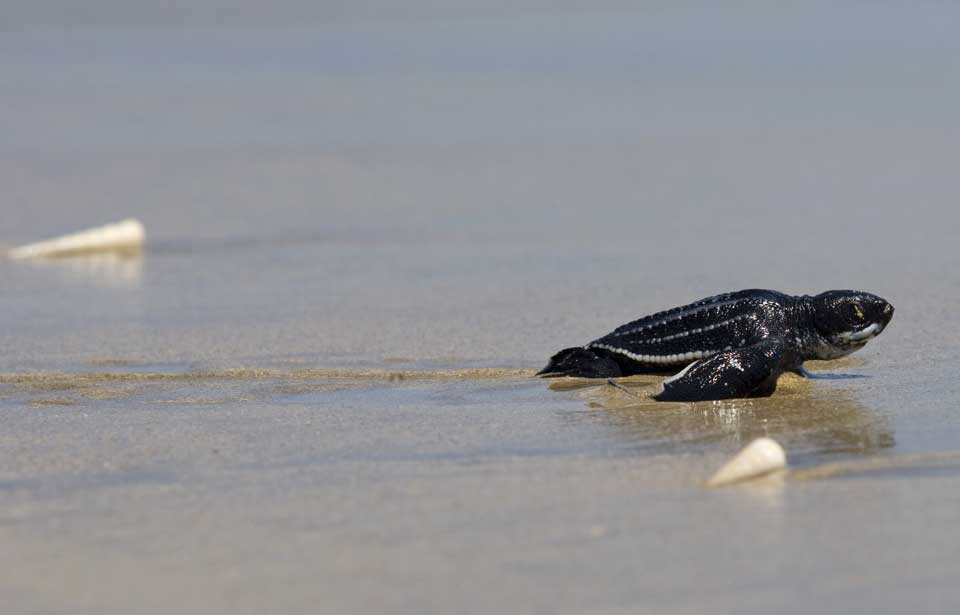
 This turtle
This turtle